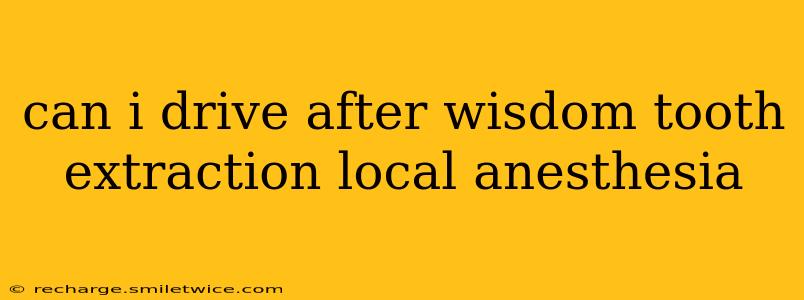Can I Drive After Wisdom Tooth Extraction Under Local Anesthesia?
Having your wisdom teeth removed can be a significant event, and understanding the post-operative care is crucial for a smooth recovery. One common question patients ask is: Can I drive after wisdom tooth extraction under local anesthesia? The simple answer is: probably not, and it's best to err on the side of caution. While local anesthesia numbs the area, its effects wear off, and other factors can impact your ability to drive safely.
Let's delve into the details and address some frequently asked questions.
What are the effects of local anesthesia?
Local anesthesia numbs the area around your wisdom teeth, minimizing pain during the procedure. However, this numbness doesn't just disappear instantly. You'll experience a gradual return of sensation, and the lingering effects can include:
- Numbness and tingling: This can affect your mouth, tongue, lips, and even parts of your face. This reduced sensation can impair your coordination and ability to react quickly, which is essential for safe driving.
- Drowsiness and dizziness: Some individuals experience drowsiness or dizziness as a side effect of the local anesthetic or any prescribed pain medication. These conditions significantly compromise your driving ability.
- Jaw stiffness: The surgery itself can cause some jaw stiffness, making it difficult to operate your vehicle effectively and safely.
How long does the numbness last?
The duration of numbness varies depending on the type and amount of anesthetic used, as well as individual factors. It can range from a few hours to several hours. It's not just about the numbness wearing off completely; the lingering effects can still impair your driving ability.
What about pain medication?
Many oral surgeons prescribe pain relievers after wisdom tooth extraction. Even if the numbness has worn off, these medications can cause drowsiness, dizziness, and impaired judgment. Driving while under the influence of prescription pain medication is illegal and extremely dangerous.
What are the legal implications?
Driving while impaired, whether by anesthesia, medication, or a combination of both, is illegal. You could face serious legal consequences, including fines, license suspension, or even criminal charges, if you are involved in an accident.
What are safer alternatives to driving?
Arrange for a friend, family member, or ride-sharing service to take you home after your procedure. Plan ahead and ensure you have reliable transportation lined up before your surgery.
When can I drive again?
You should only drive once you are fully alert, free from the effects of anesthesia and pain medication, and your jaw feels comfortable enough for you to safely operate a vehicle. This usually takes at least 24 hours, but it's best to consult your oral surgeon for specific advice tailored to your situation. They will assess your individual recovery and provide guidance on when it is safe for you to drive again.
What if I need to drive for an emergency?
In the event of a genuine emergency, prioritize your safety and the safety of others. If you absolutely must drive, carefully weigh the risks and consider calling for help first. Even in an emergency, it is crucial to prioritize safety. Call 911 or another emergency service if necessary.
In conclusion: Prioritize your safety and the safety of others. Do not drive after wisdom tooth extraction under local anesthesia until you are fully recovered and have consulted your oral surgeon. Planning ahead for alternative transportation is crucial for a safe and stress-free recovery.
